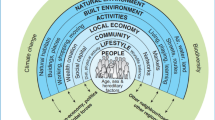Abstract
Place is more than physical and natural environment. The role of biophysical environment has still to be articulated in population health discourse and its relations with human health are fraught with scientific uncertainty and dissension. An environmental impact assessment (EA) evaluates the environmental effects of a proposal - a rational and technical process. Sometimes health assessments are included, usually by quantitative risk assessments which are subject to the limits of scientific knowledge and bedevilled by data limitations. The goal must be to add health to the process, yet the relevant features to include are complex. Impacts are non-specific and they interact and have spatial and temporal characteristics. To integrate environment into population health, there is a need for a physical environment-health database and intersectoral policy and action. There is also a need for different types of indicators to measure process, impact and effectiveness, and for new tools (stories, photography) to account for context and values.
Abrégé
Un endroit n’est pas seulement un environnement physique et naturel. Le rôle de l’environnement biophysique reste à définir dans le discours sur la santé de la population, et ses liens avec la santé humaine soulèvent beaucoup d’incertitudes scientifiques et d’opinions dissidentes. Les études d’impact sur l’environnement évaluent les répercussions d’un projet sur l’environnement - il s’agit d’un processus rationnel et technique. Il arrive que les évaluations sur la santé soient incluses, habituellement dans le cadre des évaluations quantitatives des risques qui sont limitées aux connaissances scientifiques et tronquées par les limitations des données. L’objectif doit être d’ajouter la santé au processus même si les caractéristiques qui intéressent sont complexes. Les impacts ne sont pas spécifiques; ils interagissent entre eux et possèdent des caractéristiques spatiales et temporelles. Pour intégrer l’environnement à la santé de la population, il nous faut disposer d’une base de données santé - environnement physique, avoir des politiques intersectorielles et agir. Nous avons également besoin de différents types d’indicateurs pour mesurer le processus, son impact et son efficacité, et nous devons également avoir de nouveaux outils (récits, photos) pour prendre en compte le contexte et les valeurs.
Similar content being viewed by others
References
Mustard F, Frank J. The Determinants of Health. Toronto: Canadian Institute of Advanced Research, 1991.
Evans R, Stoddart G. Producing health, consuming healthcare. Soc Sci Med 1990;31:1347–63.
Amick B, Levine S, Tarlov AR, Walsh DC (Eds.), Society and Health. New York: Oxford University Press, 1995.
Putnam R. Bowling alone. J Democracy 1995;6:65–78.
Wilkinson R. Unhealthy Societies. London: Routledge, 1996.
Hertzman C, Frank J, Evans RG. Heterogeneities in health status and the determinants of population health. In: Evans RG, Barer M, Marmor T (Eds.), Why Are Some People Healthy and Others Not? New York: Aldine de Gruyter, 1994.
Kearns R. Place and health. Professional Geographer 1993;46:111–15.
Kearns R, Gesler W (Eds.), Putting Health into Place. Syracuse: Syracuse University Press, 1998.
Duncan C, Jones K. Health-related behaviour in context. Soc Sci Med 1996;42:817–30.
MacIntyre S, McIver S, Sooman A. Area, class and health. J Social Policy 1993;22:213–34.
McBride J, Gallagher RP, Theriault G, et al. Power-frequency electric and magnetic fields and risk of childhood leukemia in Canada. Am J Epidemiol 1999;149:831–42.
Green L, Miller AB, Villeneuve PJ, et al. A casecontrol study of childhood leukemia in southern Ontario, Canada, and exposure to magnetic fields in residences. Int J Cancer 1999;82:161–70.
James J, Eyles J. Perceiving and representing both health and the environment. Qualitative Health Research 1999;9:86–104.
Costanza R, Norton BG, Haskell BD (Eds.), Ecosystem Health. Washington: Island Press, 1992.
Frizzell A, Pammett J. Shades of Green. Ottawa: Carleton University Press, 1997.
Health Canada. A Vital Link. Ottawa: Ministry of Supply and Services, 1992.
World Health Organization. Our Planet, Our Health. Geneva: WHO, 1993.
Ontario, Our Environment, Our Health. Toronto: Premier’s Council, 1993.
Davies K, Sadler B. Environmental Assessment and Human Health. Ottawa: Health Canada, 1997.
Davies K. Health and environmental impact assessment in Canada. Can J Public Health 1991;82:19–21.
National Research Council. Issues in Risk Assessment. Washington: National Academy Press, 1993.
National Research Council. Understanding Risk. Washington: National Academy Press, 1995.
Von Stackelberg K, Burmaster D. A discussion on the use of probabilistic risk assessment in human health impact assessment. Environmental Impact Assessment Review 1994;14:385–401.
Martin J. Environmental health impact assessment. Environmental Impact Assessment Review 1986;6:7–48.
Frank J, Gibson B, Macpherson M. Information needs in epidemiology. In: Fowler R (Ed.), Information Needs in Environmental Studies. Toronto: Institute for Environmental Studies, 1988.
Harr J. A Civil Action. New York: Harper, 1996.
Giroult E. WHO interest in environmental health impact assessment. In: Wathern P (Ed.), Environmental Impact Assessment. London: Unwin Hyman, 1988.
Ratner P, Green CW, Frankish J, Larsen C. Setting the stage for health impact assessment. J Public Health Policy 1998;18:67–79.
Shah C. Public Health and Preventive Medicine in Canada. Toronto: University of Toronto Press, 1998.
Beck U. Risk Society. London: Sage, 1992.
Cole D, Eyles J, Gibson B, Ross N. Links between humans and ecosystems. Health Prom Int 1999;14:65–72.
Brown P. Popular epidemiology and toxic waste contamination. J Health Soc Behav 1992;33:267–81.
Phillimore P, Moffatt S. Discounted knowledge. In: Popay J, Williams G (Eds.), Researching the People’s Health. London: Routledge, 1994.
Marcus G, Fischer M. Anthropology as Cultural Critique. Chicago: University of Chicago Press, 1986.
Roe E. Narrative Policy Analysis. Durham: Duke University Press, 1994.
McMullan C, Eyles J. Risky business. Social Problems 1999;46:294–311.
PEI Department of Health and Social Services Scan and Plan. Charlottetown: DHSS, 1998.
Author information
Authors and Affiliations
Corresponding author
Additional information
The author acknowledges Health Canada and the Institute of Health Promotion Research for assistance in attending the conference at which the paper was first presented.
Rights and permissions
About this article
Cite this article
Eyles, J.D. Health, Environmental Assessments and Population Health: Tools for a Complex Process. Can J Public Health 90 (Suppl 1), S31–S34 (1999). https://doi.org/10.1007/BF03403576
Published:
Issue Date:
DOI: https://doi.org/10.1007/BF03403576




